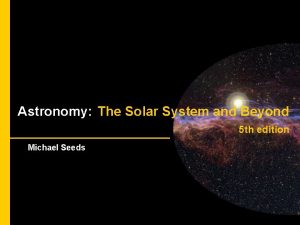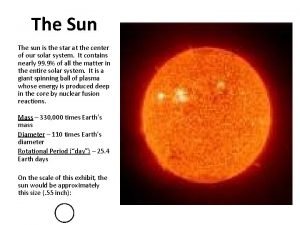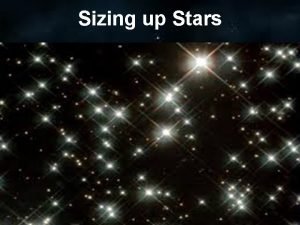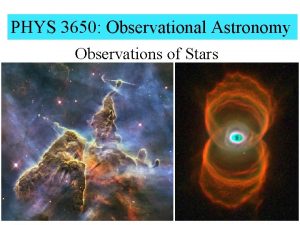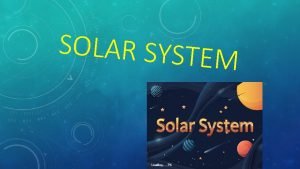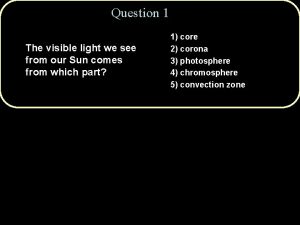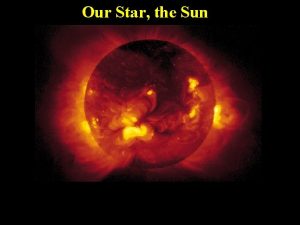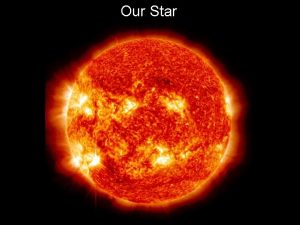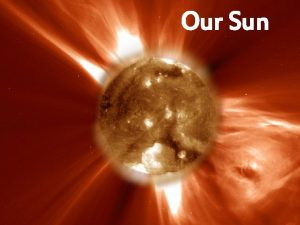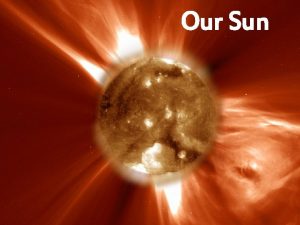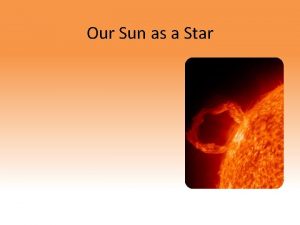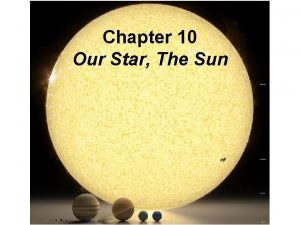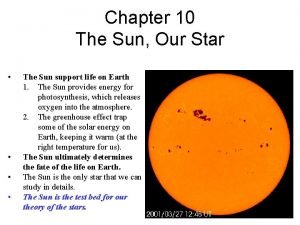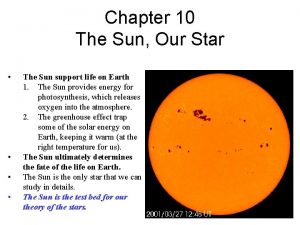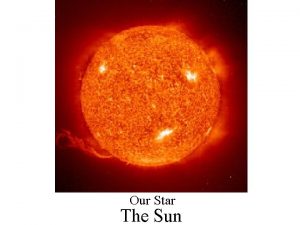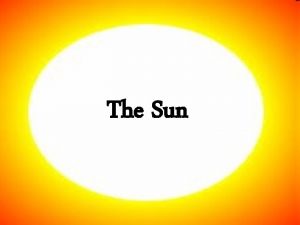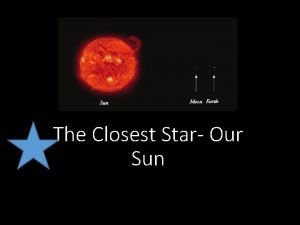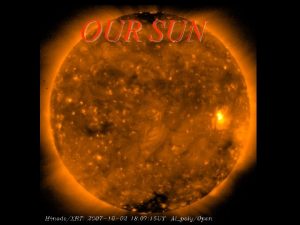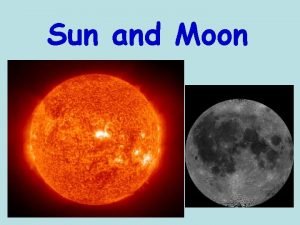Chapter 16 The Sun Our Star The Sun

































- Slides: 33

Chapter 16 The Sun, Our Star

The Sun • The Sun is a star, a luminous ball of gas more than 100 times bigger than the Earth • Telescopic observations reveal a bevy of violent activity – fountains of gas and twisting magnetic fields • The Sun’s core is equally violent with thermonuclear fusion converting hydrogen into helium equivalent to the detonation of 100 nuclear bombs every second. • The force of gravity keeps the Sun from blowing up – for now

The Sun • With a radius 100× and a mass of 300, 000× that of Earth, the Sun must expend a large amount of energy to withstand gravitational collapse

Properties of the Sun • The Sun’s distance from Earth (about 150 million km or 1 AU) was once measured by triangulation, but is now done by radar • Once the distance is known, its diameter (about 1. 4 million km) can be found

Properties of the Sun • From the Sun’s distance and the Earth’s orbital period, Kepler’s modified third law gives the Sun’s mass • The surface temperature (5780 K) is found from the Sun’s color

Properties of the Sun • The Sun is gaseous throughout with a core temperature of about 15 million Kelvins. • The amount of solar energy that reaches the Earth is 4 × 1026 watts (400, 000, 000, 000) • The Sun has plenty of hydrogen for fusion: its surface spectra shows hydrogen is 71% and 27% helium.

The Structure of the Sun

The Solar Interior • The low density upper layers of the Sun, where any photons created there can freely escape into space is called the photosphere • The photosphere is the yellow “surface” we see with our eyes • Layers below the photosphere are opaque.

The Radiative Zone • Since the core is hotter than the surface, heat will flow outward from the Sun’s center • Near the Sun’s center, energy is moved outward by photon radiation – a region surrounding the core known as the radiative zone

The Radiative Zone • Photons created in the Sun’s interior do not travel very far before being reabsorbed – energy created in the Sun’s center will take about 16 million years to eventually diffuse to the surface!

The Convection Zone • Above the radiative zone energy is more efficiently transported by the rising and sinking of gas – this is the convection zone

STOP HERE TODAY

Granulation • Convection manifests itself in the photosphere as granulation, numerous bright regions surrounded by narrow dark zones

The Sun’s Atmosphere • The extremely low-density gases that lie above the photosphere make up the Sun’s atmosphere

The Sun’s Atmosphere • The density of the atmosphere decreases steadily with altitude and eventually merges with the nearvacuum of space • Immediately above the photosphere, the temperature of the atmosphere decrease but at higher altitudes, the temperature grows hotter, reaching temperatures of several million Kelvin • The reason for the increase in temperature is unknown, but speculation is that Sun’s magnetic field plays an important role

The Chromosphere • The lower part of the atmosphere is referred to as the chromosphere – The chromosphere appears as a thin red zone around the dark disk of a totally eclipsed Sun – The red is caused by the strong red emission line of hydrogen Ha – The chromosphere contains millions of thin columns called spicules, each a jet of hot gas

The Corona • Temperature in the corona eventually reaches about 1 million K (not much energy though due to low density) • The corona, visible in a total solar eclipse, can be seen to reach altitudes of several solar radii • The corona is not uniform but has streamers and coronal holes dictated by the Sun’s magnetic field

How the Sun Works • The inward (holding) force is the Sun’s own gravity, while the outward (noncollapsing) force arises from the Sun’s internal gas pressure Without balance the Sun would rapidly change!

Powering the Sun • Given that the Sun loses energy as sunshine, an internal energy source must be present to maintain equilibrium – If the Sun were made of pure coal, the Sun would last only a few thousand years – If the Sun were not in equilibrium, but creating light energy from gravitational energy (the Sun is collapsing), the Sun could last 10 billion years

STOP HERE TODAY

Powering the Sun • Mass-energy is the key – In 1905, Einstein showed that energy and mass were equivalent through his famous E = mc 2 equation – 1 gram of mass is equivalent to the energy of a small nuclear weapon – Sun’s core temperature is high enough to force together atoms

Solar Neutrinos • The nuclear fusion process in the Sun’s core creates neutrinos • Neutrinos lack electric charge, have a very small mass, escape the Sun’s interior relatively unaffected, and shower the Earth (about 1 trillion pass through YOU every second!!!)

Sunspots • Dark-appearing regions ranging in size from a few hundred to a few thousand kilometers across • Last a few days to over a month • Darker because they are cooler than their surroundings (4500 K vs 6000 K) • Cooler due to stronger magnetic fields within them

Origin of Sunspots • Starved of heat from below, the surface cools where the magnetic fields breach the surface creating a dark sunspot

Prominences • Prominences are huge glowing gas plumes that jut from the lower chromosphere into the corona

Prominences • Prominence gas is confined by its high magnetic field and hot surrounding gas • Gas streams through prominence in a variety of patterns • Always associated with sunspots

Solar Flares • Sunspots give birth to solar flares, brief but bright eruptions of hot gas in the chromosphere • Hot gas brightens over minutes or hours, but not enough to affect the Sun’s total light output

Solar Flares • Some flare eruptions can explosively shoot gas across the Solar System and result in spectacular auroral displays

The Solar Wind • The corona’s high temperature gives its atoms enough energy to exceed the escape velocity of the Sun • As these atoms stream into space, they form the solar wind, a tenuous gas of hydrogen and helium that sweeps across the entire Solar System • The amount of material lost from the Sun via the Solar Wind is insignificant • Typical values at the Earth’s orbit: a few atoms per cm 3 and a speed of about 500 km/sec • At some point, the solar wind mingles with interstellar space

The Solar Cycle • Sunspot, flare, and prominence activity change yearly in a pattern called the solar cycle • Over the last 140 years or so, sunspots peak in number about every 11 years • Climate patterns on Earth may also follow the solar cycle

Differential Rotation • The Sun undergoes differential rotation, 25 days at the equator and 30 at the poles

Cause of the Solar Cycle • This rotation causes the Sun’s magnetic field to “wind up” increasing solar activity (magnetic field “kinks” that break through the surface) as it goes • The cycle ends when the field twists too “tightly” and collapses – the process then repeats

Changes in the Solar Cycle • The cycle may vary from 6 to 16 years • Considering the polarity direction of the sunspots, the cycle is 22 years, because the Sun’s field reverses at the end of each 11 -year cycle • Leading spots in one hemisphere have the same polarity, while in the other hemisphere, the opposite polarity leads
 Bearing gifts we traverse afar
Bearing gifts we traverse afar Diff between a* and ao*
Diff between a* and ao* What does star in star events stand for?
What does star in star events stand for? Many students work on the star our school newspaper
Many students work on the star our school newspaper Dark patch on our star
Dark patch on our star Thinking affects our language, which then affects our:
Thinking affects our language, which then affects our: Our census our future
Our census our future Christ be our light shine in our hearts
Christ be our light shine in our hearts Our life is what our thoughts make it
Our life is what our thoughts make it We bow our hearts
We bow our hearts Our census our future
Our census our future Our life is what our thoughts make it
Our life is what our thoughts make it Summary of the poem money madness
Summary of the poem money madness Awareness of ourselves and our environment is
Awareness of ourselves and our environment is Our awareness of ourselves and our environment.
Our awareness of ourselves and our environment. God our father christ our brother
God our father christ our brother Our future is in our hands quotes
Our future is in our hands quotes Our awareness of ourselves and our environment.
Our awareness of ourselves and our environment. Is our awareness of ourselves and our environment.
Is our awareness of ourselves and our environment. How far is venus from the sun in miles
How far is venus from the sun in miles How hot are stars
How hot are stars The sun compared to other stars
The sun compared to other stars Star sun solar
Star sun solar The visible light we see from our sun comes from which part
The visible light we see from our sun comes from which part 1995 january 23 nasa
1995 january 23 nasa Hát kết hợp bộ gõ cơ thể
Hát kết hợp bộ gõ cơ thể Bổ thể
Bổ thể Tỉ lệ cơ thể trẻ em
Tỉ lệ cơ thể trẻ em Voi kéo gỗ như thế nào
Voi kéo gỗ như thế nào Tư thế worms-breton
Tư thế worms-breton Chúa sống lại
Chúa sống lại Các môn thể thao bắt đầu bằng tiếng đua
Các môn thể thao bắt đầu bằng tiếng đua Thế nào là hệ số cao nhất
Thế nào là hệ số cao nhất




